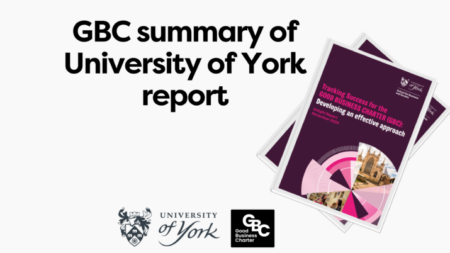Summary of University of York report: Tracking Success for the Good Business Charter
The University of York, School for Business and Society published a report entitled: Tracking Success for the Good Business Charter: Developing an effective approach in November 2024.
Below are key paragraphs quoted directly from the report, followed by our response to the recommendations it raises.
Conclusion
The GBC initiative represents a transformative force in the business landscape, championing a model of ethical capitalism where profitability and ethical practices are intertwined. It has already made a significant impact by embedding values that benefit both businesses and society, encouraging organisations to commit to high standards of responsibility and integrity.
Furthermore, the GBC serves as a bridge, fostering collaborative synergies between the public and private sectors through the GBC framework. By promoting shared ethical standards and values, the GBC helps align business objectives with societal needs, creating a more cohesive and integrated approach to sustainable development. Through these efforts, the GBC is paying the way for a more just, sustainable, and inclusive economy, where ethical and sustainable practices and profitability go hand in hand.
Foreword
“The GBC is not just a certification; it is a movement; ushering in a new era of business integrity and accountability. Built around ten core principles – ranging from paying a real living wage to environmental stewardship and employee well-being – the GBC framework transforms the complexity of ethical business into a simple, actionable roadmap. What distinguishes the GBC is its ability to cut through the clutter of other frameworks, offering a concise yet powerful system that is already gaining traction with FTSE100 companies, local authorities, SMEs and independent entrepreneurs. This is the future of responsible business.”

Kiran Trehan, Pro-Vice Chancellor for Partnerships, University of York
Executive Summary
The report investigates the development and effectiveness of the Good Business Charter (GBC). It evaluates the GBC model, compares it with other ethical business frameworks, and explores areas for improvement.
The findings highlight the cohesion, scope and conciseness of the GBC accreditation. Accredited organisations widely praised the GBC’s structure as a systematic approach to integrating ethical practices into daily operations. The GBC was described as holistic and well-integrated, with clear, non-overlapping measures that provide a comprehensive set of goals.
Its core values align well with objectives such as creating wealth, improving cost efficiency, enhancing productivity, providing high-quality customer service, and maintaining strong stakeholder relations. This compatibility allows the GBC to be seamlessly incorporated into existing operations without conflicting with other organisational priorities. The GBC’s light-touch approach and compact, focused framework were particularly valued for these reasons.
Compared to other frameworks, the GBC addresses similar aspects of defining and measuring ethical and sustainable business practices, but in a more streamlined and practical manner, with distinct focuses, scopes and applications.
GBC Values for Business and Society
Through an inductive qualitative analysis, seven GBC values perceived by member organisations are identified.
Transforming the business landscape into a more ethically driven community
Providing a pragmatic framework of ethical business practice
Facilitating alignment between ethical commitments and business operations
Driving ethical improvement and operational efficiency
Serving as an external standard for responsible business practices
Infusing organisations with tangible value(s)
Infusing organisations with intangible value(s)
Opportunities for the GBC
By making ethical practices more accessible and relevant, the GBC can drive broader adoption across diverse sectors, ensuring that businesses of all sizes can participate in and benefit from ethical standards.
By implementing transparent and regular auditing mechanisms, the GBC can maintain its credibility and demonstrate that membership signifies a genuine commitment to ethical practices. Strengthening verification processes will help ensure that businesses are not merely using the GBC as a symbolic gesture but are actively fulfilling their ethical commitments. This approach can enhance trust among stakeholders and reinforce the value of the GBC as a rigorous and impactful standard for responsible business conduct.
By educating consumers and other stakeholders about the specific actions and commitments, the GBC can enhance the perceived value of its standards and promote a deeper appreciation of its principles. This heightened awareness can help differentiate GBC-certified businesses in the marketplace and encourage wider adoption of ethical practices.
By encouraging collaboration and community engagement, the GBC can amplify the collective impact of ethical practices and foster a culture of continuous improvement.
By clearly articulating the business case for ethics, beyond just moral and reputational benefits, the GBC can help businesses understand the tangible value of membership. This evidence-based approach can encourage more businesses to adopt ethical practices, sustain their commitments over time, and see ethical conduct as a strategic asset that contributes to long-term success.
Trust-building through GBC membership is an intangible yet crucial benefit. To deepen this trust, the GBC could encourage or require members to publicly disclose the specific actions they have taken to adhere to its principles. This could involve publishing detailed reports or case studies that outline the steps business ideas are taking to meet GBC standards and the impacts of these actions.
By encouraging a culture of continuous ethical improvement, the GBC can help businesses maintain their commitments and navigate the balance between ethical ideals and practical realities.
Our response to the report
We are really grateful to the University of York for the research undertaken and are looking forward to implementing recommendations particularly around increased brand awareness and mechanisms such as special interest groups and other member-led initiatives as we continue to refine and develop the Charter.
We believe true embedding of the GBC includes gap analysis, internal audit, annual reporting, and having a clearly identified GBC champion within each organisation –and this is an area we want to keep highlighting and promoting.
There was a section about strengthening our verification but there was no reference made of our whistle-blowing which is a key mechanism that ensures organisations are held to account because if any one of their employees, customers, suppliers or other stakeholder believes they are not compliant with the GBC’s 10 components, they can raise a concern directly with our team to be investigated. We want to look at how we make stakeholders of GBC organisations more aware of this whistle-blowing mechanism.
Many of the recommendations are things we are already working on such as state collaboration, raising awareness among supply chains, awards and recognition and public relations through partnership. Every year we evaluate our components and questions and we are comfortable with the level of rigour we have and the way it works for all sizes and sectors, although of course we will endeavour to continually improve on an ongoing basis.


